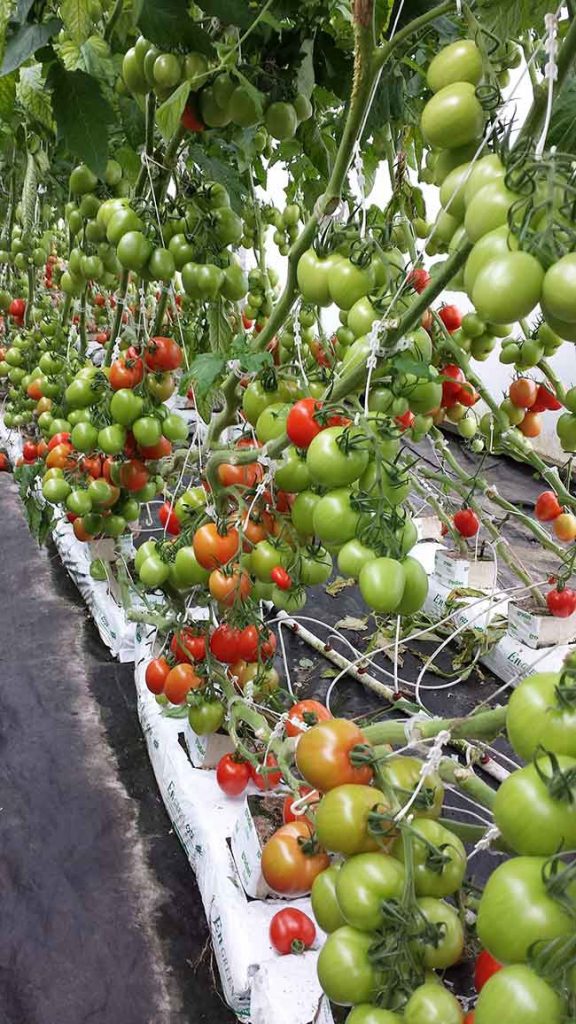
Features
Structures & Equipment
Water and irrigation
ABCs of pH in Vegetable Crops
Rootzone pH can be influenced by several factors and growers must understand those inputs.
September 16, 2015 By Dr. Mohyuddin Mirza
 This photo highlights pH issues with tomatoes. In other examples observed, iron deficiency symptoms can also be seen with top growth as well.
This photo highlights pH issues with tomatoes. In other examples observed, iron deficiency symptoms can also be seen with top growth as well. October 2015 – I have written extensively on pH and electrical conductivity (EC) issues and management in bedding plants in Greenhouse Canada (March 2014 and earlier editions). Basically there are plants such as geraniums and impatiens, among others, that change the pH of the growing media towards the acidic side. However, plants such as petunias and calibrachoa, among many others, change the pH towards the alkaline side.
The leaf symptoms in the first case are of iron toxicity; in the second case, the symptoms are of iron deficiency. Sometimes we refer to these plants as iron efficient and in-efficient plants.
There are other inputs, such as fertilizer and water, that also cause changes in the pH of the growing medium.
The pH-related issues are prevalent in cucumbers and tomatoes, and to a lesser degree in peppers. Cucumbers are prolific root producers, followed in order by tomatoes and peppers. Cucumbers constantly have to produce new roots and with the limited growing media volume, the pH and EC related issues develop and have to be managed more proactively.
With this feature I will discuss pH related problems with cucumbers and tomatoes.
The first picture (photo 1) shows a top view of cucumber crop where iron deficiency has started due to pH of over 6.8 for a week. On closer examination, one can see green veins and yellowing interveinal area which is typical of iron and manganese deficiencies. The second photo (photo 2) on page 38 shows the opposite end of the pH spectrum. The pH in this case was going below 4.9 for almost a month. The grower was trying to find individual nutrient issues. My diagnosis was iron and manganese toxicity due to very acidic pH which was confirmed with a tissue sample analysis. Iron was close to over 500 mg/kg while manganese was over 1200 mg/kg.
The starting point is the pH of the growing medium. In Alberta, coir is most commonly used for these vegetable crops. Check the pH of the leach after the bags have been thoroughly wetted. Generally it is in the desirable range of between 5.8 and 6.2.
The seedlings are grown in rockwool blocks, so check the pH by squeezing nutrient solution out of these blocks. I have seen a range of pH in these blocks because the plants are not using much fertilizer at this stage and the pH of the fertilizer solution will affect the pH levels in the block.
I have also found that EC can rise fairly high in these seedlings blocks due to surface evaporation of water. In one case, the EC was over 6 mmhos/cm and pH was around 5.2. Under high VPD situations, the seedlings can be damaged.
Most growers monitor leach pH regularly. But I am finding that leach pH depends on the volume of fertilizer solution going through the roots and the condition of those roots. When roots are very active, the pH will start creeping up and when fruit load is very high, that is more than the plant can handle, and then the roots suffer. They don’t get much assimilate, and the pH starts dropping.
Why is it important to monitor squeeze pH? Most times, if I find that leach pH is going below 5.2 and before changing the feed pH, I would suggest growers to take a “squeeze pH” as well. This means taking coir and manually squeezing the nutrient solution out of it to take a pH reading. I have found that the “squeeze pH” may be significantly lower than the leach. Then corrective measures have to be taken very quickly.
MONITORING pH
Note that pH is monitored at many points in the greenhouse cucumber production chain. It starts with an understanding of acidity and alkalinity of individual fertilizers. The basic principle is that the fertilizers with nitrate nitrogen will be more alkaline in nature while the fertilizers with more ammonium nitrogen will be acidic in nature.
It’s therefore important you should understand the carbonates and bicarbonates in your water supply. If you are using RO water then bicarbonates may have to be added to provide some buffering capacity.
Most of the commercial cucumber growers have automatic fertilizer dosing systems and controllers. Growers have different options. I have seen cases where incoming water is pH adjusted, treated with whatever disinfectants are deemed desirable based on water quality, and then stored. From there the water picks up nutrients from tank A and tank B, the pH is adjusted again based on the computer set points, and it is then delivered to the drip lines. Proper proportions need to be worked out for reuse when recycled water is collected.
Other growers use in-line pH and EC sensors, ensuring the desired pH adjustments are made. My recommendations are to adjust feed pH to between 5.8 and 6.2 for coir-based growing media. It’s important the pH sensors are calibrated frequently – preferably every week, not after a few months.
The pH is influenced by root health, which itself is affected by what is going on at the top.
A grower with whom I consult with shared the two pictures (upper right) with me. Photo 3 is a heavily loaded Long English cucumber crop. Photo 4 is how the roots look when there is such a heavy fruit load. This is a very critical time when attention should be paid to root health. Check for any evidence of rots.
What happens is that the plant food resources are transferred preferentially to the fruit at the expense of the roots. The development of new roots suffers and thus pH could go on the acidic side. Growers must be proactive in managing such drops in pH and that can be done only when pH readings are taken twice daily for growers to assess the trend. Raising the pH may take a longer time and plant damage can occur. A proper adjustment in 24-hour temperature is also required to transfer more food resources to the roots.
Tomato crops also need regular pH monitoring. The photo on page 36 highlights pH issues with tomatoes, although I have seen serious iron deficiency symptoms with the top growth as well. The yellowing of the middle leaves, which can be confused with magnesium deficiency, is very common with very heavy fruit load around late April on crops planted in January. The roots undergo a decay and the pH drops in the growing medium. The plants recover after the fruit is removed.
The main takeaway message here is to monitor pH on a regular basis and try to maintain a level between 5.8 and 6.2. The pH in the rootzone can be influenced by several factors and growers must know and understand those inputs.
Dr. Mohyuddin Mirza is an industry consultant. • drmirzaconsultants@gmail.com
Print this page




